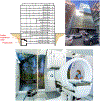Our journeys through the fascinating world of proton radiation therapy
- PMID: 36502491
- PMCID: PMC10257772
- DOI: 10.1002/mp.16118
Our journeys through the fascinating world of proton radiation therapy
Abstract
The purpose of this article is to share the excitement of the science of proton therapy, told by two physicists, who started their career in this area at different times. The authors' journey spans the evolution of proton therapy over the past 30 years, taking the reader from the time when it was an extremely exotic treatment modality until its more common use today. Over this time period, the authors' research and development aimed at an improved understanding of the physical benefits of intensity-modulated proton therapy and arc therapy, treatment planning and optimization to take proton-specific uncertainties into account, and imaging to measure the proton range in the patient. The final section focuses on emerging themes to democratize proton therapy by substantially reducing its size and price, for much greater affordability and global availability of this treatment modality.
Keywords: adaptive therapy; arc therapy; democratization of proton therapy; image guidance; intensity-modulated proton therapy; proton therapy; range verification; robust optimization.
© 2022 American Association of Physicists in Medicine.
Figures




References
-
- Clasie BM, Bortfeld T, Kooy HM, Seybolt K, Sharp GC, Winey B. Retrofitting LINAC Vaults for Compact Proton Systems—Experiences Learned. IEEE Transactions on Radiation and Plasma Medical Sciences 2021;6(3):282–287.
Publication types
MeSH terms
Substances
Grants and funding
LinkOut - more resources
Full Text Sources
Miscellaneous

